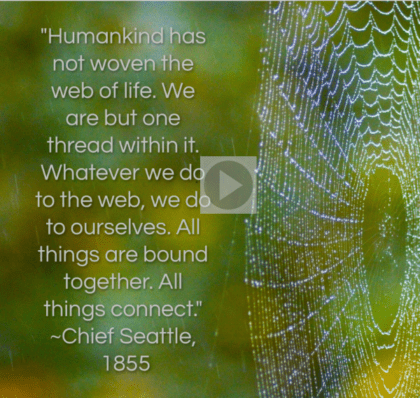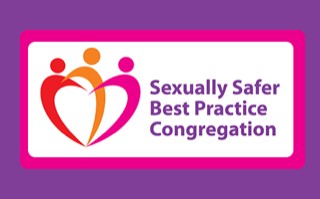 Reading by Chief Dan George, Tsleil-Waututh
Reading by Chief Dan George, Tsleil-Waututh
The beauty of the trees,
the softness of the air,
the fragrance of the grass,
speaks to me.
The summit of the mountain,
the thunder of the sky,
the rhythm of the sea,
speaks to me.
The strength of the fire,
the taste of salmon,
the trail of the sun,
and the life that never goes away,
they speak to me.
And my heart soars.
Sermon
I got to spend some time on the cape this summer, and after months of being cooped up in my apartment I longed to go for a walk on the beach. It’s an iconic yearning, right – the wind blowing through your hair, the distant cry of seagulls, a sense of infinity, a sense of connection with the vastness of everything. Only the ocean and the horizon as far as the eye can see.
So I set off early, before the rest of the family was up. I had a handy map, with directions to the public beach parking lot. As I walked, I could smell the salt, noticed the houses appearing more and more sun-bleached as I walked. And then, there… was the parking lot, and one of those little splintery wooden walkways that leads to the shore. Ahhh.. I’m here.
I made my way down, gulping deep breaths of ocean air, gazing/soaking in the distant horizon…. Then I took off my shoes, felt the sand in my toes, turned left, and started walking. I got about 10 feet when I spotted a sign. “Private beach” it said “Keep out” Okay, no worries, so I turned around and walked the other way, within about 20 feet I noticed another little sign – Private beach, keep out. And then I spotted another about 20 feet beyond that, and then another – no trespassing.
Hm.
Very small public beach, this. So I gingerly made my way back up the walkway, and looked up another public beach parking lot on my phone. Made my way there. Down another walkway. 10 feet to the left hit a sign, turned around, 20 feet to the right another sign. Private beach. No trespassing. More signs in the distance. Private beach private beach private beach. One after the other. For as far as my eye could see.
Disappointed, no long iconic beach walk for me that day, I turned around to head back toward the street.
As I turned, I spotted a house up on a ledge, just to my left. I could see what looked like a family, having breakfast maybe. Overlooking their little ocean plot. For some reason, in that moment, they looked so small, a little lonely maybe, even a little lost, like they were missing out on something important. Something really vast.
That memory came back to me as I was preparing for today’s service on indigenous people’s day. What some still call Columbus Day. When land was “discovered,” taken, divided up and sold. My beachfront experience is just one tiny legacy of that very old reality.
I’ve been learning more about that history. It was a focus of our UU general assembly in June.
What did actually happen, in that red-letter year of 1492?
What happened after that? In what ways is that legacy still with us?
[pause]
There is a something called the doctrine of discovery that, I confess, I knew very little about until a few years ago. Maybe some of you are aware of it, or maybe it’s as new to you as it was to me. It’s actually been around since 1493. Not coincidentally the year after Columbus landed on this soil. It was [based on] a legal proclamation, issued by the Pope, that justified the taking of land, around the world, by Christian Europeans. Ignoring the rights of people already there.
Labeling indigenous people as savages, this doctrine paved the way for the incomprehensible cruelty and genocide that happened here. It made land theft legal. Here, and everywhere around the world. Not only legal, but encouraged.
Now on the one hand, that sounds like really old news, right? This was 1493 – a lot of things happened a long time ago that were brutal and cruel and from which most people would recoil today.
But this thing wasn’t just a law.
It was a law, that was fueled by an attitude. An attitude that says – I am entitled. I get to have this. My rules win, because they’re mine. It’s based on hubris. And dismisses people who you see as unlike you, with their foreign language or different culture, it dismisses people who you do not see as a part of your world. And it leads, as we have seen, to cruelty, and ruthlessness, in policies and actions. Frankly, not just here, but globally.
It’s part of a whole way of seeing the world that became embedded into the consciousness of a number of what many call “western” countries, including this one.
This doctrine sits so deep and has had such staying power that it was used as recently as 2005 in a Supreme Court decision here. In fact, given this country has never repudiated it, it still could be used that way today.
It has led to policies that deny native people full rights to even the small bits of land which they were left by these early “discoverers”. They only occupy it, this 19th century statute still says.
A strange truce that is part of the deep denial of the real truth of history.
That real truth is something quite different from the falsehoods many of us grew up with.
As Lakota activist Bill Means has said, it wasn’t that Columbus discovered America, it was that “we discovered Columbus, lost on our shores, sick, destitute, and wrapped in rags. We nourished him to health, and the rest is history. He represents the mascot of American colonialism in the Western Hemisphere. And so it is time that we change a myth of history.”
It is time to change the myth of history.
A myth that, like a poisonous tree, began with lies and grew and branched out over time. From that ancient trunk, we can now find troubling leaves everywhere.
Lies, distortions and disrespect are everywhere…
The doctrine of discovery was, basically, state-sanctioned stealing, cheating and lying. Setting a precedent for some of what we are seeing, today.
The doctrine hardened into law this idea that the earth is somehow meant to be owned and dominated. An attitude that has become part of our culture and painfully shows in how we treat our earth today. (those leaves are everywhere)
And the doctrine propagated this lie about what and who is important – there are those who are to be respected, heard, honored, and those who are not. And, those who are not, are to be dominated or gotten rid of. This lie, that led to the genocide of this county’s first people, also sits at the root of centuries of American slavery, sexism, ableism, and oppressions of all kinds.
The leaves are everywhere.
These days, Native Americans, while not actively destroyed, are made invisible, disrespected, and sidelined all the time.
Ojibwe historian Jean O’Brien calls it “firsting and lasting.” Towns create monuments to what they call the “first settlement” or “first dwelling,” as if there had never been occupants in those places before Euro-Americans. Meanwhile, she says, a national narrative tells of “last Indians” or “last tribes”: the last of the Mohicans or the famous sculpture by James Earl Fraser of a mounted Indian slumped over his horse entitled “End of the Trail.”[1]
The truth is, settlers were not first, and native Americans are not gone. In spite of the all the atrocities committed against them.
The truth is this county’s indigenous people are here. Their cultures are alive, their ways of living precious and resilient. As the book “Lies my teacher told me” puts it, theirs is not a history of defeat but of survival and persistence.
And their existence is a testament to different kinds of culture. To different kinds of attitudes about life and this planet that predates the ones I just described earlier. So many native tribes embody ways of living that honor, and relate with respect to the natural world, and to humanity.
Unlike that tree of lies I described earlier, I picture a people tapped into a tree of integrity. Strong, with wide branches and deep roots. Resilient, but also fragile, like our earth, like any living being…
It’s a kind of poignant resilience that reminds me of a song by Paul McCartney called blackbird.
Some words: Blackbird singing in the dead of night.
Take these broken wings and learn to fly
All your life
You were only waiting for this moment to arise
McCartney wrote it in response to the little rock 9 – the 9 black teenagers who, with immense courage. were the first to desecrate their high school in Little Rock, Arkansas, in spite of overwhelming pressure for them to desist.
So when I heard that song, recorded by Mikmak teenager Emma Stevens, when I heard her sing it in her native tribal language which was almost lost, when I heard Emma speak of her pride and her feeling of connection to her roots when she sang it, I thought, this is a perfect tribute to that resilience and fragility. An expression of a unique culture and its beautiful, evocative, living language
Blackbird: https://www.youtube.com/watch?v=99-LoEkAA3w
The lies that created the doctrine of discovery have terrorized our Native American siblings, continue to marginalize them today and hurt all of us in this society.
We’ve been conditioned to believe things have to be this way. That land grabs, domination, side-lining and disrespect are inevitable.
And we’ve been conditioned to not pay attention. We’ve been conditioned to focus away from people who we see as unlike ourselves, we’ve been conditioned to focus just on what’s right in front of us, so we don’t get sidelined. But that can lead us to lose track of a wider world and all the beautiful people that it holds.
Native people are not gone. They are here. They are resilient, they are wise, and they have remained connected to truths our culture appears to have forgotten.
And they are our siblings.
And while our culture might dismiss, we can center. While our culture might send the message that it is the only culture and we who are part of it are the only people of importance, we can be intentional about listening to people who see things differently, people who, by the way, are leading the fight against climate change, people who are still fighting for recognition, for their rights, for their land.
Who we listen to, Scott Taylor writes, in his article on this month’s theme, who we listen to determines the world we live in, and it determines who we become. As individuals, and as a society.
And who we listen to can grow into caring, love, connection, identification, and a willingness to fight, together, for what is deeply right.
We can deal with that tree of poison all those leaves of poison, from where it began, taking it down at at it’s trunk, it’s roots, and by hearing the truth and telling the truth. As often as we need to.
Because all of us are part of that tree of integrity. All of us have those roots. And we can feel it, in our bones, when we connect with it.
So I want to end with something called a land acknowledgment. I first heard one when I was visiting Seattle a few years ago. The city tour guide began her talk by sharing the names of all the tribes who had been there first. And what we owed them. She listed all of them. And she did this at the beginning of every single tour. So that these people, and this history of theft and erasure, was *not* forgotten. It struck me. It was important.
These particular land acknowledgment words were written by Ana Maria De La Rosa.
Take a moment to center yourself in a land acknowledgment, she writes, not as a function of ownership or reclamation, not as an empty exercise with no accountability – but rather as a continuation of our role as stewards . Thank the Indigenous and Native caretakers of the land you are on and from – if you know their names, speak them and if you do not, commit to learning them. In this moment, with your hand over your heart, commit to personally taking whatever steps are necessary towards land reparations. To our native brothers and sisters we say, you are still here, we will not erase you.
Thank the African hands and bodies that have toiled the land you are on – a role forced on them originally through enslavement. Thank them for the seeds they brought over hidden and braided in their hair, seeds that still sustain us . Gratitude for the farming and stewarding wisdom we have inherited and continue to learn from . This place that carries their blood, sweat and tears – these too tell the story of place . In this moment, with your hand over your heart, commit to personally taking whatever steps are necessary towards reparations. Honor their memory in this moment, in humble gratitude.
Keeping your hand on your heart, take a moment to acknowledge that you too are land. You are the continuation of the story of place. Thank your body for the ways it holds your landscapes. Interrupt the belief that there is separation between you and nature, you are merely an extension. You are Land personified. To be stewards of the land includes protecting your heart as fiercely as you would the redwoods, a beehive, the ocean. To admit we are land means we commit to tending to each other as well. In this moment, with your hand over your heart, commit to personally taking whatever steps are necessary towards tenderly tending yourself, and each other.
There is a vast, deep, important truth and so many of us are missing it.
As we begin to right our relationship with those who were here first, as we look at the roots, the trunk, of what has been so broken, we will begin to heal.
Let us listen to those who were here first, and connect with the integrity of our own ancestors, that we may find our connection and our common cause.
May the past not keep us stuck, but teach us how to write a new story, starting today.
So that together we can right what’s wrong, and recreate the beauty of our world, stretching for as far as the eye can see.
[1] An Indigenous Peoples’ History of the United States by Roxanne Dunbar-Ortiz


 Donate Online/Pledge
Donate Online/Pledge